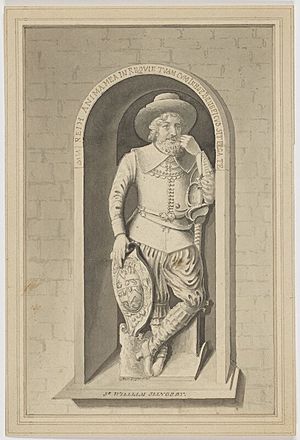William Slingsby facts for kids
Quick facts for kids
Sir William Slingsby
|
|
|---|---|
 |
Sir William Slingsby (born 29 January 1563 – died 1634) was an English soldier. He is often mistakenly thought to have found the first spa water well in Harrogate, North Yorkshire. While he did play a part in discovering the special waters there, he wasn't the very first.
Contents
Early Life and Family
William Slingsby was born in Scriven, a small place near Knaresborough in Yorkshire. He was the seventh son of Sir Francis Slingsby and Mary de Percy. His mother's family, the Percys, were very old and important. They were related to famous people like Thomas Percy, 7th Earl of Northumberland.
A Grand Tour of Europe
In 1582, William Slingsby married Elizabeth Broard. After their wedding, the couple went on a long trip called a "Grand Tour" across Europe. This was a popular way for wealthy young people to learn about different cultures and see the world. They returned home in 1594.
Discovering Harrogate's Waters
In 1596, Sir William Slingsby made an important discovery. He found that the water from the Tewit Well mineral spring in Harrogate had special healing properties. He noticed it was similar to the famous spa waters found in Spa, Belgium. This discovery helped make Harrogate a popular place for people to visit for their health.
A Career as a Soldier
Sir William Slingsby was also a brave soldier. In 1596, he fought in a military mission to Cadiz, a city in Spain. The next year, in 1597, he served again in battles against Spain. His military service showed his dedication to his country.
Public Service and Later Life
After his time as a soldier, Sir William Slingsby became involved in politics and public service.
Becoming a Member of Parliament
- In 1601, he became a Member of Parliament (MP) for Knaresborough. He served alongside his brother, Sir Henry Slingsby.
- He continued to be an MP until 1611.
- In 1603, he was given the title of Knight, becoming "Sir" William Slingsby.
- In 1626, he was elected as an MP again, this time for Appleby.
Deputy Lieutenant
In 1617, Sir William Slingsby was made a Deputy Lieutenant for Middlesex. This was an important role where he helped the main Lieutenant with local government and military matters.
Legacy
Sir William Slingsby passed away in 1634. He was buried in Knaresborough church. He had a son named Henry, who later became the Master of the Mint, a very important job in charge of making coins. He also had a daughter.
Sir William Slingsby's portrait, painted by Moses Griffith, can be seen in the National Portrait Gallery in London. A street in Covent Garden in London, called Slingsby Place, is named after him.
Images for kids


